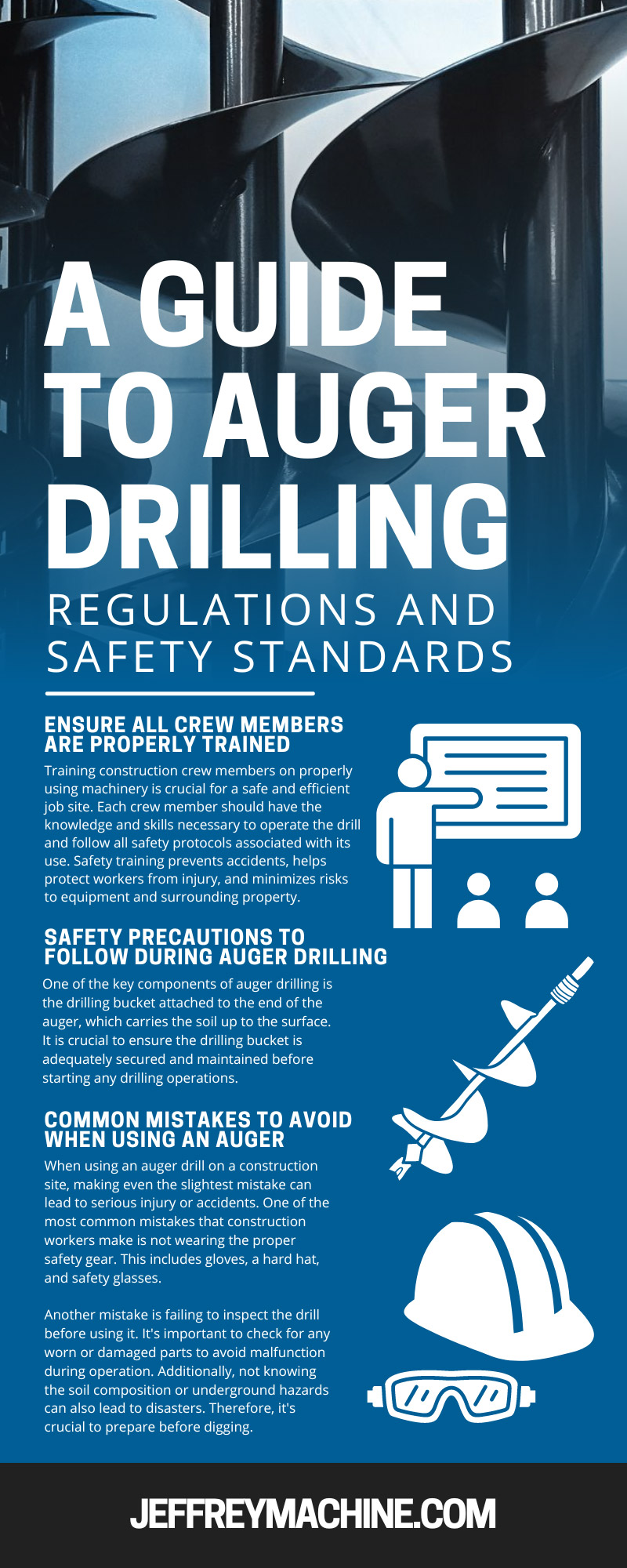A Guide to Auger Drilling Regulations and Safety Standards

For construction associates, staying current on the latest safety standards and regulations is paramount for protecting workers, preventing equipment damage, and completing projects on time. This guide to auger drilling regulations and safety standards is invaluable for keeping your team safe on the job site while ensuring a successful project outcome. After learning the information below, confidently move forward with any project.
An Overview of Augers and Their Uses
Augers are essential tools widely used in the construction, agriculture, and mining industries. These tools include large and complex drill bits attached to heavy-duty drills, enabling users to dig into the earth with precision and speed. Augers are commonly used to excavate holes, trenches, and foundation sites.
However, it is crucial to note that using drills and augers can be dangerous, and you must observe many safety standards and regulations. We cannot understate the importance of safety since incidents involving drill augers can cause severe harm to individuals and the environment. Therefore, while augers are vital to many industries, it is crucial to use caution and take measures to ensure that workplace safety remains a top priority.
OSHA Requirements for Operator Certification
In the world of construction, safety is vital. The Occupational Safety and Health Administration (OSHA) has strict guidelines for operator certification when using a large drill. These guidelines ensure that those operating heavy machinery are knowledgeable and can safely carry out their tasks.
It's important to understand these requirements, as failure to comply can result in costly fines and, more importantly, potential safety hazards. By investing the necessary time and resources into operator certification, construction companies can ensure a safer work environment for their employees and, ultimately, a more successful project.
Ensure All Crew Members Are Properly Trained
Training construction crew members on properly using machinery is crucial for a safe and efficient job site. Each crew member should have the knowledge and skills necessary to operate the drill and follow all safety protocols associated with its use. Safety training prevents accidents, helps protect workers from injury, and minimizes risks to equipment and surrounding property.
Employers who invest in their employees' training demonstrate a commitment to their well-being while also improving the overall operations of the job site. By prioritizing safety and providing comprehensive training, companies can ensure their workers can handle any task that comes their way.
Safety Precautions To Follow During Auger Drilling
Auger drilling operations are commonly used to excavate deep holes in the ground for various purposes, including foundations, soil sampling, and remediation. Although auger drilling has proven to be a very effective technique, it also requires strict safety measures to prevent accidents or injuries.
One of the key components of auger drilling is the drilling bucket attached to the end of the auger, which carries the soil up to the surface. It is crucial to ensure the drilling bucket is adequately secured and maintained before starting any drilling operations.
You should also follow other precautions, such as wearing protective gear, ensuring that underground utilities get marked, and adhering to proper installation procedures to maintain a safe drilling environment. With the appropriate safety measures, auger drilling can be an efficient excavation method that keeps crews and bystanders safe.
Common Mistakes To Avoid When Using an Auger
When using an auger drill on a construction site, making even the slightest mistake can lead to serious injury or accidents. One of the most common mistakes that construction workers make is not wearing the proper safety gear. This includes gloves, a hard hat, and safety glasses.
Another mistake is failing to inspect the drill before using it. It's important to check for any worn or damaged parts to avoid malfunction during operation. Additionally, not knowing the soil composition or underground hazards can also lead to disasters. Therefore, it's crucial to prepare before digging.
Lastly, rushing the process can be costly. Setting up and operating the drill properly can save time in the long run by preventing accidents or damages. By avoiding these common mistakes, we can ensure a safe and productive work environment for all those involved in the construction site.
How To Properly Maintain Your Auger for Long-Term Use
Keeping the tool in top shape is essential for those who rely on a drill auger for various activities. Proper maintenance is crucial not only for optimal performance but for safety.
Regular inspection of the blades, bolts, and overall structure can help prevent any malfunctions or accidents. Cleaning and oiling the blades will also increase their life span and reduce the chances of wear and tear and rust buildup.
In addition to these tips, it's also recommended to store the auger properly, away from moisture or extreme temperatures. By taking these steps and ensuring your auger is well-maintained, you can ensure its longevity and, most importantly, safety during its use.
Develop an Emergency Response Plan
Developing an emergency response plan is crucial when operating a drill auger on a construction site. Accidents can happen at any time, and having a plan in place can make all the difference when responding quickly and effectively to an injury or unforeseen circumstance.
An emergency response plan for drill auger operations should include a clear chain of command as well as specific procedures for contacting emergency services, providing first aid, and identifying and addressing potential hazards before they cause harm.
Once you have a plan, it should be thoroughly communicated to all workers on the construction site. Hold regular training sessions to ensure everyone is familiar with the correct procedures in the event of an emergency. By taking the time to develop and implement a strong emergency response plan, construction companies can significantly reduce risks to their workers and ultimately improve project outcomes.
It's crucial to be aware of auger drilling regulations and safety standards. Following the guidelines set by OSHA, training all on-site employees, developing an emergency response plan, and regularly maintaining your auger are essential steps in ensuring a safe working environment.
Keep in mind that these steps don’t guarantee perfect safety; however, they do minimize risks enough so that complicated operations can get carried out safely. Auger drilling is useful for many situations, but one must always keep in mind the tremendous responsibility it carries and take any necessary precautions for everyone involved.

